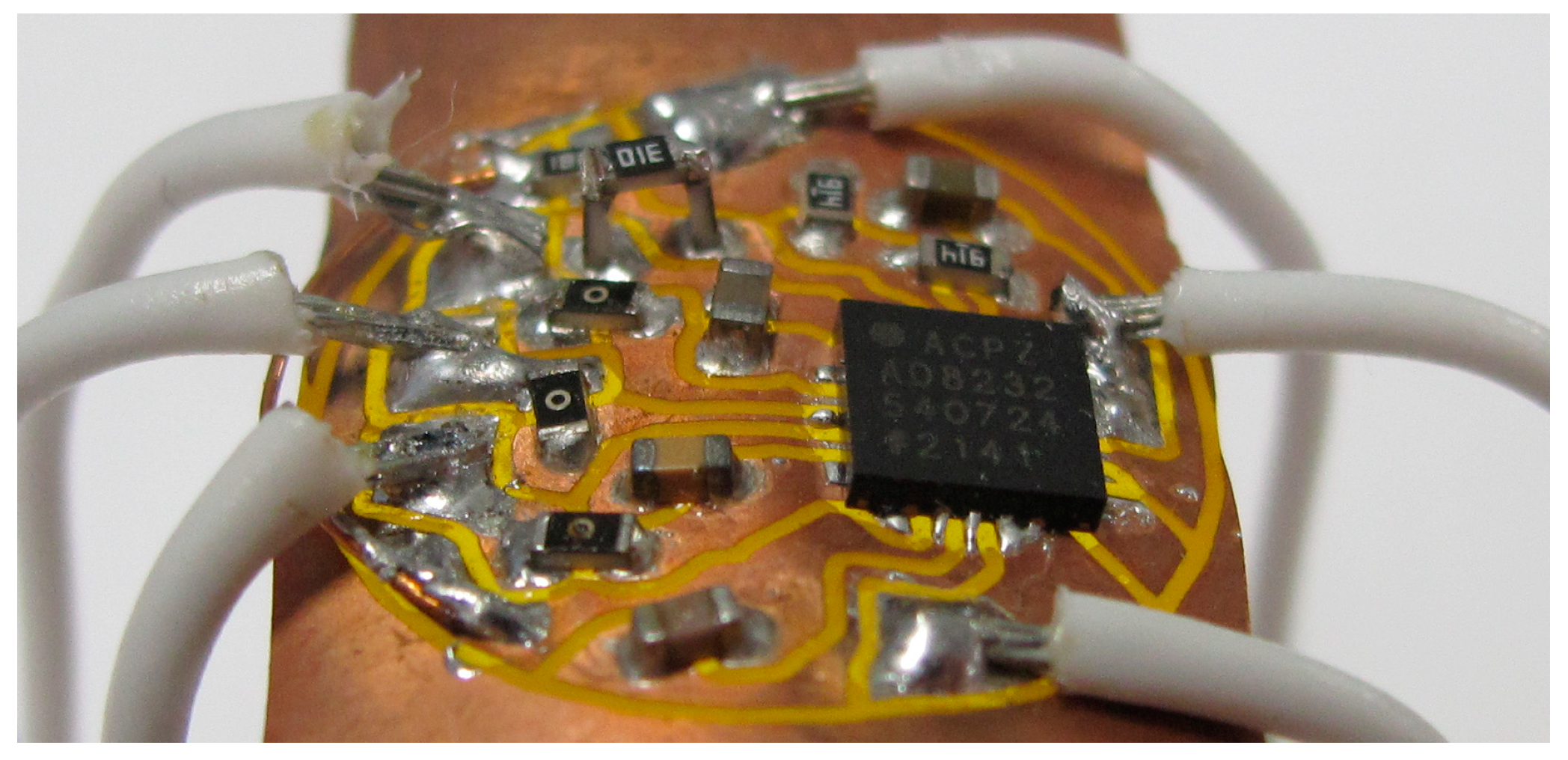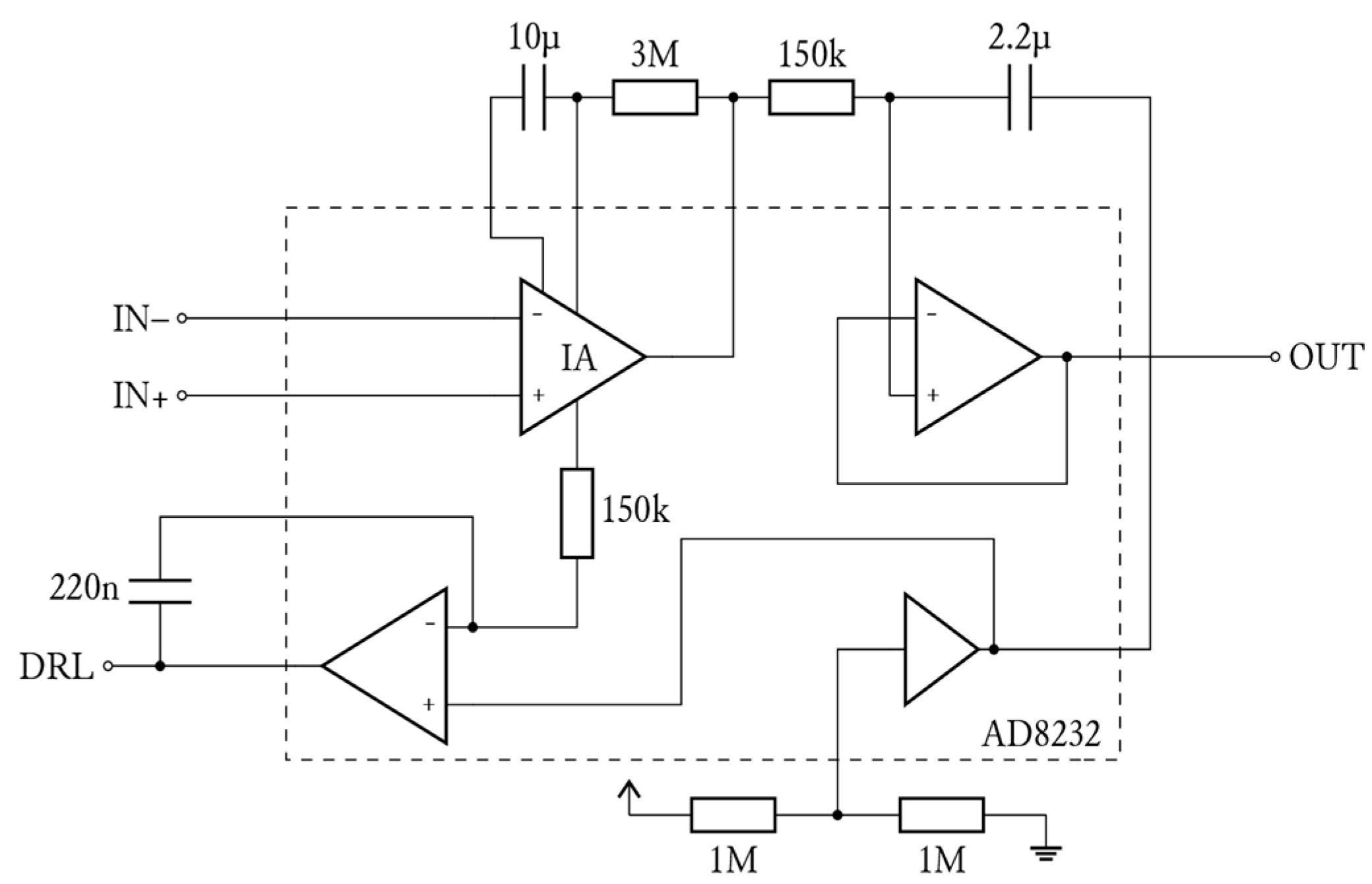The Influence of Distance between the Electrode and Noise Reduction Buffer Amplifiers in ECG Monitoring Using Knitted Electrodes †
Abstract
1. Introduction
2. Method
3. Results
4. Conclusions
Author Contributions
Funding
Institutional Review Board Statement
Informed Consent Statement
Data Availability Statement
Conflicts of Interest
References
- Fobelets, K.; Hammour, G.; Thielemans, K. Knitted ECG Electrodes in Relaxed Fitting Garments. IEEE Sens. J. 2023, 23, 5263–5269. [Google Scholar] [CrossRef]
- Terada, T.; Toyoura, M.; Sato, T.; Mao, X. Noise-Reducing Fabric Electrode for ECG Measurement. Sensors 2021, 21, 4305. [Google Scholar] [CrossRef] [PubMed]
- Paul, G.; Torah, R.; Beeby, S.; Tudor, J. Novel active electrodes form ECG monitoring on woven textiles fabricated by screen and stencil printing. Sens. Actuators A Phys. 2015, 221, 60–66. [Google Scholar] [CrossRef]




| SNR/dB | |
|---|---|
| 4.507 | Gel Electrode |
| 4.917 | Knitted with buffer 0 cm away |
| 3.396 | Knitted with buffer 2 cm away |
| 4.67 | Knitted with buffer 5 cm away |
| 3.157 | Knitted with buffer 10 cm away |
| −3.733 | Knitted with buffer 20 cm away |
Disclaimer/Publisher’s Note: The statements, opinions and data contained in all publications are solely those of the individual author(s) and contributor(s) and not of MDPI and/or the editor(s). MDPI and/or the editor(s) disclaim responsibility for any injury to people or property resulting from any ideas, methods, instructions or products referred to in the content. |
© 2024 by the authors. Licensee MDPI, Basel, Switzerland. This article is an open access article distributed under the terms and conditions of the Creative Commons Attribution (CC BY) license (https://creativecommons.org/licenses/by/4.0/).
Share and Cite
Greig, T.; Jopling, K.; Irving, Z.; Altamirano, D.; Perry, H.; Cheong, Y.; Torah, R.; Yang, K. The Influence of Distance between the Electrode and Noise Reduction Buffer Amplifiers in ECG Monitoring Using Knitted Electrodes. Eng. Proc. 2023, 52, 20. https://doi.org/10.3390/engproc2023052020
Greig T, Jopling K, Irving Z, Altamirano D, Perry H, Cheong Y, Torah R, Yang K. The Influence of Distance between the Electrode and Noise Reduction Buffer Amplifiers in ECG Monitoring Using Knitted Electrodes. Engineering Proceedings. 2023; 52(1):20. https://doi.org/10.3390/engproc2023052020
Chicago/Turabian StyleGreig, Tom, Kate Jopling, Zackery Irving, Diego Altamirano, Helen Perry, Ying Cheong, Russel Torah, and Kai Yang. 2023. "The Influence of Distance between the Electrode and Noise Reduction Buffer Amplifiers in ECG Monitoring Using Knitted Electrodes" Engineering Proceedings 52, no. 1: 20. https://doi.org/10.3390/engproc2023052020
APA StyleGreig, T., Jopling, K., Irving, Z., Altamirano, D., Perry, H., Cheong, Y., Torah, R., & Yang, K. (2023). The Influence of Distance between the Electrode and Noise Reduction Buffer Amplifiers in ECG Monitoring Using Knitted Electrodes. Engineering Proceedings, 52(1), 20. https://doi.org/10.3390/engproc2023052020








